| View previous topic :: View next topic |
| Author |
Message |
thataway
Joined: 02 Nov 2003
Posts: 20803
City/Region: Pensacola
State or Province: FL
C-Dory Year: 2007
C-Dory Model: 25 Cruiser
Vessel Name: thataway
Photos: Thataway
|
 Posted: Mon Dec 21, 2020 1:34 pm Post subject: Posted: Mon Dec 21, 2020 1:34 pm Post subject: |
 |
|
Rob,
What is the battery charging capacity of the Renology 1000 watt inverter/ charger?
The one I found was only 30 amps and there were a fair number of low ratings on amazon. Is there a different model which has higher output and better ratings?
Also how are you approaching the over heating of the flexible solar panels when laid on a surface without ventilation beneath them?
What is your real life experience with the output of the three, 175 watt solar panels? (I think you have a Victron 712 in the system?-I didn't see it in the diagram)...
Are you only relying on the engine to charge the engine start battery?
Thanks
_________________
Bob Austin
Thataway
Thataway (Ex Seaweed) 2007 25 C Dory May 2018 to Oct. 2021
Thisaway 2006 22' CDory November 2011 to May 2018
Caracal 18 140 Suzuki 2007 to present
Thataway TomCat 255 150 Suzukis June 2006 thru August 2011
C Pelican; 1992, 22 Cruiser, 2002 thru 2006
Frequent Sea; 2003 C D 25, 2007 thru 2009
KA6PKB
Home port: Pensacola FL |
|
| Back to top |
|
 |
robhwa
Joined: 04 Dec 2013
Posts: 272
City/Region: Anderson Island
State or Province: WA
C-Dory Year: 2003
C-Dory Model: 22 Cruiser
Vessel Name: Marcia C
Photos: Problemadela
|
 Posted: Mon Dec 21, 2020 5:09 pm Post subject: Posted: Mon Dec 21, 2020 5:09 pm Post subject: |
 |
|
| thataway wrote: | Rob,
What is the battery charging capacity of the Renology 1000 watt inverter/ charger?
The one I found was only 30 amps and there were a fair number of low ratings on amazon. Is there a different model which has higher output and better ratings?
Also how are you approaching the over heating of the flexible solar panels when laid on a surface without ventilation beneath them?
What is your real life experience with the output of the three, 175 watt solar panels? (I think you have a Victron 712 in the system?-I didn't see it in the diagram)...
Are you only relying on the engine to charge the engine start battery?
Thanks |
Inverter-Charger: Renogy inverter/charger/transfer switch 1000 is 30 amps, 2000 is 65 amps. All 12 volts. These things are big and heavy, the 2000 is 51 lbs. However, you get an inverter AND a 120 volt charger with an internal transfer switch. I'm not sure I need 65 amps for my plans. I have a 2000 in my house through a panel transfer switch. Been testing, and works fine so far, charging at rated (>60 amps) and can put out steady 2000 watts, and a lot more for a few seconds. I plan to test this in the CD22 this Spring/Summer and see if I like it. All of these electronics will reside inside the galley cabinet.
Overheating Panels: I haven't had a lot of problem with overheating of solar panels. They do get hot. Reading earlier about flexible panels glued to roofs, I anticipated the problem which is one reason I didn't glue them, and had planned to slip 3/4 x 3/4" wood strips under during intense days to provide airflow on the backside of the panels. Not needed, but we'll see with the SW trip.
Diagram I Posted: Let me review, this diagram I posted would create a turn-key system, and I will install this spring/summer. Testing most of it in my camper now.
Earlier, I had a hodge-podge. 175 watt panels bungied on roof, charge controller BZ MPPT500, feeding into a two series-wired AGM Group 31 for a 24-volt system. Battery charging through TrollBridge 12x24 and generator or shore charging with a 40 amp Cabelas charger. All bases covered, but what a mess, and poor charging from the Honda 90! Simply going from the two AGM to two Lithium should reduce 60 lbs and give me more useful power and faster charging when available. Testing in the camper confirms this...I believe my only weak link will be the 17 amps of charging from the Honda 90. Overall weight will be reduced.
One advantage of the new system is that the starting battery will also be charged by the large solar panels, not just the main motor alternator. I already had a 5 watt "maintainer" panel hooked to the starter battery, and experienced full charge almost all of the time. I really liked the TrollBridge, but can't use with Li batteries, and it won't be needed. If proposed turnkey system doesn't work, I'll fall back to this default system on the C-Dory and keep the other in the camper where I don't need 24 VDC.
Panel performance: So far, so good. Back in July, when we had sun, the panels would often output well, sometimes at 30 amps, 20 volts. Usually, that was full sun with a cool breeze. Output goes down as they heat up. If I go back to a 24 volt system, I may try and add more panels. Hope this helps! |
|
| Back to top |
|
 |
jkidd
Joined: 23 Oct 2006
Posts: 1615
City/Region: Northern, Utah
State or Province: UT
C-Dory Year: 2007
C-Dory Model: 22 Cruiser
Vessel Name: Voyager
Photos: Voyager (JK)
|
 Posted: Sun Dec 27, 2020 9:20 pm Post subject: Posted: Sun Dec 27, 2020 9:20 pm Post subject: |
 |
|
I started my test this afternoon I took my house battery down to 85 percent and ran the motor at 950 rpms to charge it back up. Next picture is the house battery status.
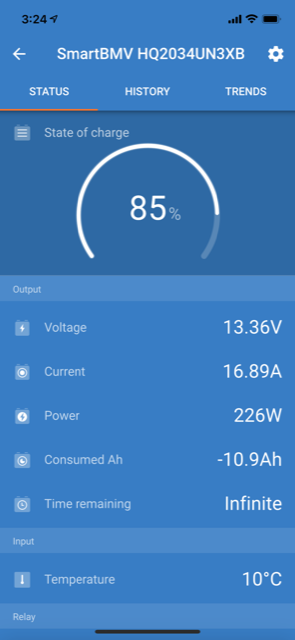
Next Picture is the start battery status.
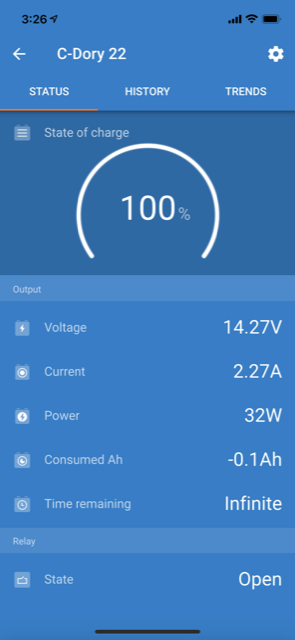
Next picture is the DC to DC charger status in Bulk mode.
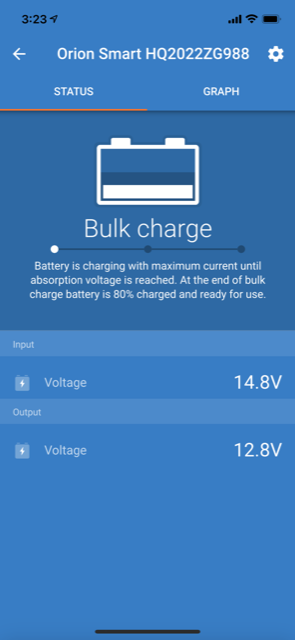
It took roughly 6 minutes to switch from bulk to absorption mode.
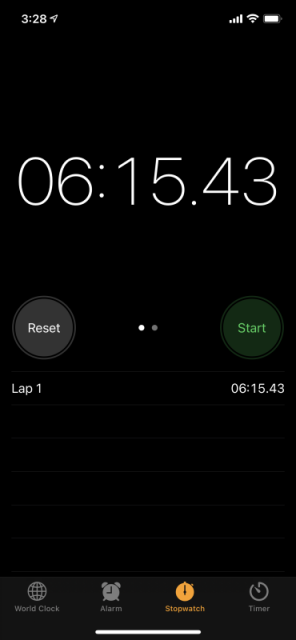
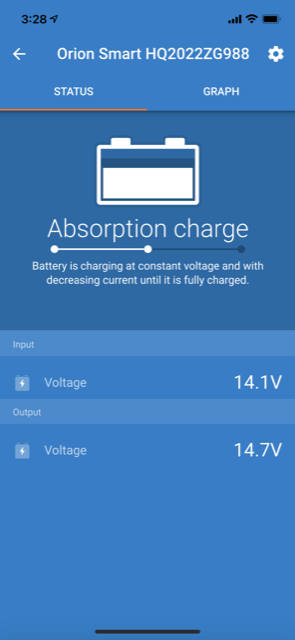
I took temperatures of the charge coil during the test the highest reading was 130 degrees F. this was right at the end of the bulk mode. More to come later.
_________________
Jody Kidd
KE7WNG
Northern, Utah
 |
|
| Back to top |
|
 |
thataway
Joined: 02 Nov 2003
Posts: 20803
City/Region: Pensacola
State or Province: FL
C-Dory Year: 2007
C-Dory Model: 25 Cruiser
Vessel Name: thataway
Photos: Thataway
|
 Posted: Sun Dec 27, 2020 9:25 pm Post subject: Posted: Sun Dec 27, 2020 9:25 pm Post subject: |
 |
|
| Jody were these the LI or lead acid batteries? |
|
| Back to top |
|
 |
jkidd
Joined: 23 Oct 2006
Posts: 1615
City/Region: Northern, Utah
State or Province: UT
C-Dory Year: 2007
C-Dory Model: 22 Cruiser
Vessel Name: Voyager
Photos: Voyager (JK)
|
 Posted: Sun Dec 27, 2020 9:35 pm Post subject: Posted: Sun Dec 27, 2020 9:35 pm Post subject: |
 |
|
| Both batteries are Agm. I have the new Battleborn sitting in the kitchen havenít installed it yet. |
|
| Back to top |
|
 |
jkidd
Joined: 23 Oct 2006
Posts: 1615
City/Region: Northern, Utah
State or Province: UT
C-Dory Year: 2007
C-Dory Model: 22 Cruiser
Vessel Name: Voyager
Photos: Voyager (JK)
|
 Posted: Mon Dec 28, 2020 2:51 pm Post subject: Posted: Mon Dec 28, 2020 2:51 pm Post subject: |
 |
|
The next series of photos take you through the state of charge with the voltage and current readings.
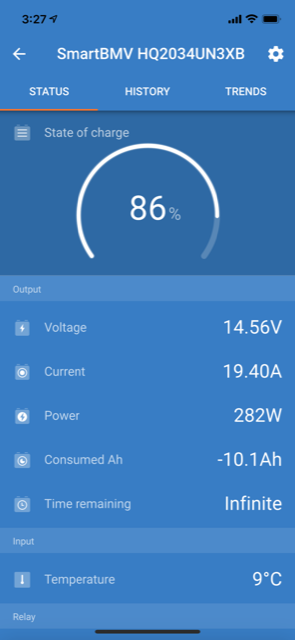
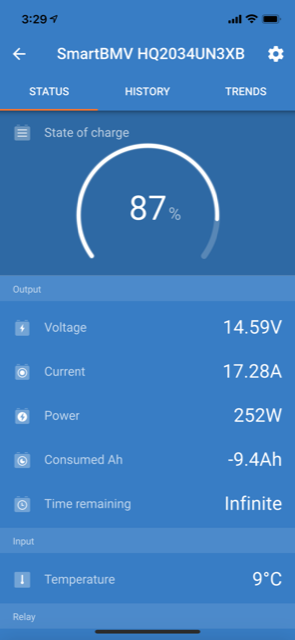
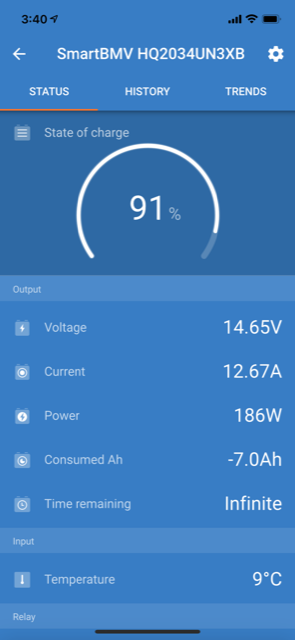
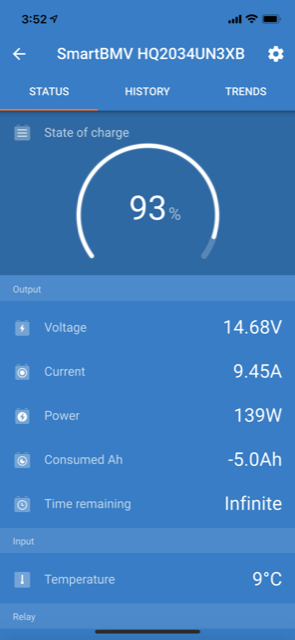
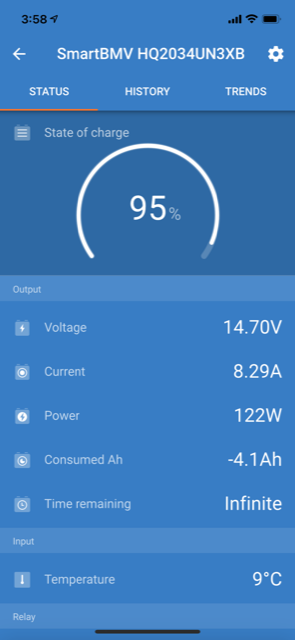
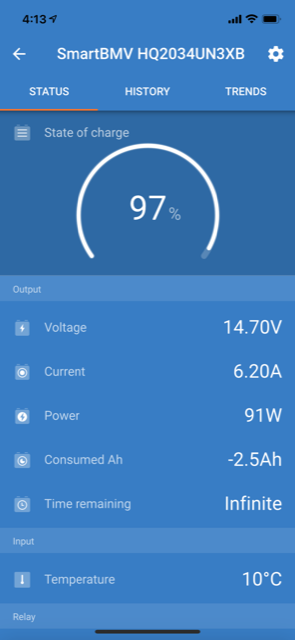
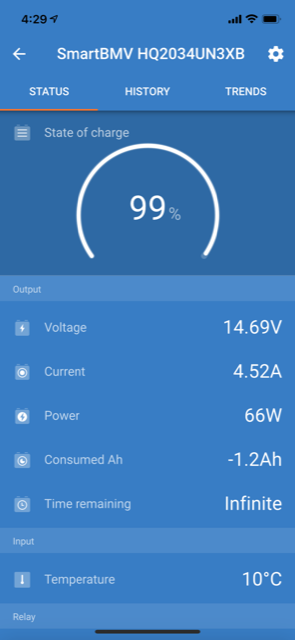
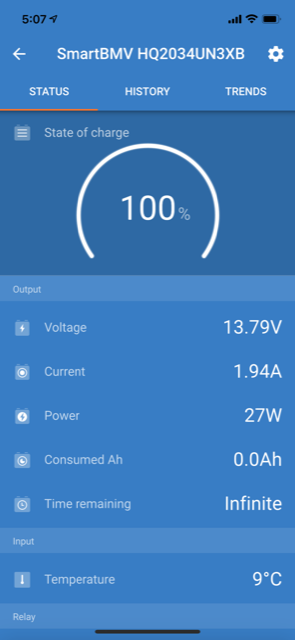
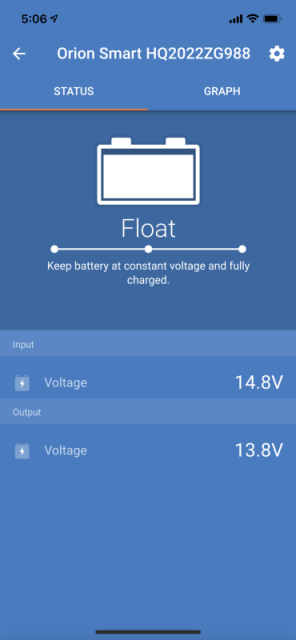
I started the test at 3:24 pm and finished at 5:07 pm and reached a float charge at 5:06 pm.
In looking at the numbers I wouldn't spend the extra money to get the 30 amp charger and would just use the 18 amp charger instead. I am going to leave the 30 amp installed in mine. |
|
| Back to top |
|
 |
smckean (Tosca)
Joined: 18 Jan 2014
Posts: 975
City/Region: Guemes Island (Anacortes)
State or Province: WA
C-Dory Year: 2005
C-Dory Model: 25 Cruiser
Vessel Name: Tosca
Photos: Tosca
|
 Posted: Wed Dec 30, 2020 12:03 am Post subject: Posted: Wed Dec 30, 2020 12:03 am Post subject: |
 |
|
| jkidd wrote: | | In looking at the numbers I wouldn't spend the extra money to get the 30 amp charger and would just use the 18 amp charger instead. |
A few years ago I purchased and installed a quality ProMarine 36amp charger. It has 2 outputs, but will put all 36 amps into only 1 output if the other battery is fully charged. I was disappointed that the charger has never outputted more than 20 amps to the house batteries. I finally decided that how many amps a charger feeds to a depleted battery depends on that battery's state of charge (SOC). Since none of us take our batteries down below about 50% SOC (I'm talking lead/acid to AGM here), I'm assuming full charger output is never used.
What I've never figured out is whether that state of affairs (assuming I'm even correct in my analysis) depends on the charger or the battery. That is, if for example, my 36 amp charger outputs 20 amps in a given situation, would a 20 amp charger also put out 20 amps in that same situation, or would the output scale with the charger's maximum output (i.e., the 20 amp charger might only output say 13 amps).
Anyone know the answer?
_________________
Sandy McKean
Purchased Tosca in 2014
Re-powered to Yammi 200 in 2015 |
|
| Back to top |
|
 |
robhwa
Joined: 04 Dec 2013
Posts: 272
City/Region: Anderson Island
State or Province: WA
C-Dory Year: 2003
C-Dory Model: 22 Cruiser
Vessel Name: Marcia C
Photos: Problemadela
|
 Posted: Wed Dec 30, 2020 12:46 pm Post subject: Posted: Wed Dec 30, 2020 12:46 pm Post subject: |
 |
|
| smckean (Tosca) wrote: | | jkidd wrote: | | In looking at the numbers I wouldn't spend the extra money to get the 30 amp charger and would just use the 18 amp charger instead. |
A few years ago I purchased and installed a quality ProMarine 36amp charger. It has 2 outputs, but will put all 36 amps into only 1 output if the other battery is fully charged. I was disappointed that the charger has never outputted more than 20 amps to the house batteries. I finally decided that how many amps a charger feeds to a depleted battery depends on that battery's state of charge (SOC). Since none of us take our batteries down below about 50% SOC (I'm talking lead/acid to AGM here), I'm assuming full charger output is never used.
What I've never figured out is whether that state of affairs (assuming I'm even correct in my analysis) depends on the charger or the battery. That is, if for example, my 36 amp charger outputs 20 amps in a given situation, would a 20 amp charger also put out 20 amps in that same situation, or would the output scale with the charger's maximum output (i.e., the 20 amp charger might only output say 13 amps).
Anyone know the answer? |
Chargers. How many amps flows into a charging battery can be a mystery. The charger is part of the process, but only part. The battery must ACCEPT amps from the charger as well. In my measurements, a single FLA never accepted 36 amps at 50% charge or more. I never wanted to damage my FLAs so I didn't draw below 50% SOC. When I have drawn down to 50% SOC and monitored charging acceptance, it seems that the online rule of 25% or 0.25 for FLA works reasonably well, so only 25A max for a single 100A FLA even with an infinite charger due to internal resistance that increases with SOC. That means (in theory) you would need at least two FLA to accept your full 36A. Also, claims from chargers may be like claims from FLA batteries....you won't get 100AH out of a 100AH battery and you probably won't get stated amps out of a charger.
Cables. Cables are another factor. You can lose a lot of amps as heat from cables that can't handle the load (i.e. long runs of even fairly large cables) through voltage drop. You may not notice it at all unless you measure voltage at both ends or it is really bad and cables get hot. Mostly the heat just dissipates. I generally don't use the cables supplied with a system, as they are usually not adequate for the task. Buy large cables, get a crimper, and make the runs as short as possible.
Batteries. LiFePO4 are a different horse. In my measurements, they can take a lot of Amps. BattleBorn's BMS, for instance, doesn't limit charging amps, but recommends 0.5 (50A) for charging, and states that it can take 100A for short periods. Hooking a large (i.e. >200AH) system to a truck alternator with cabling sufficient to handle extremely large AH is a recipe for ruining your alternator, particularly large loads with the vehicle not moving so air isn't cooling it. This is generally not an issue with FLAs because of internal resistance limiting current flow.
I don't think the alternators used in most motors with C-Dorys will have Amps high enough to be an issue. My Honda 90 only offers a max of 17 amps, and the newer ones only about 35 amps. |
|
| Back to top |
|
 |
jkidd
Joined: 23 Oct 2006
Posts: 1615
City/Region: Northern, Utah
State or Province: UT
C-Dory Year: 2007
C-Dory Model: 22 Cruiser
Vessel Name: Voyager
Photos: Voyager (JK)
|
 Posted: Mon Jan 11, 2021 5:10 pm Post subject: Posted: Mon Jan 11, 2021 5:10 pm Post subject: |
 |
|
I have the LI battery installed for the house in the port lazarette and the dc to dc charger in the same space. I wanted to keep the wires as short as possible. So far these are the advantageís that I am seeing.
Battery weighs 29 lbs the AGM battery weighs 78 lbs for a savings of 49 lbs.
If there were 2 house batteries I would save 120 lbs for the same capacity.
I can now use nearly 100 percent of the rated capacity instead the 50 percent of lead acid.
The LI battery does not need to be charged back up to 100 percent within 24 hours like lead acid.
The LI battery likes to be kept between 30 to 90 percent with no ill effects.
I can run multiple days without charging and use the capacity of the battery if I like.
I can disable the dc to dc charger if the LI battery doesnít need charging.
Donít have to worry about over charging the house battery when batteries are combined.
The LI battery life is 3000 to 5000 cycles 4 to5 times the life of lead acid.
I will be doing the same charge test that I did with the AGM house battery to see the results.
While this is pricey up front over time it will pay for itself might not have to buy another house battery for 15 years or more and if I buy a new boat I can move that battery to the new one. |
|
| Back to top |
|
 |
croakz
Joined: 21 Sep 2020
Posts: 104
City/Region: Seattle
State or Province: WA
C-Dory Year: 1997
C-Dory Model: 22 Angler
Vessel Name: Jolly Blue
Photos: Jolly Blue
|
 Posted: Tue Sep 07, 2021 1:11 am Post subject: Posted: Tue Sep 07, 2021 1:11 am Post subject: |
 |
|
@jkidd You mentioned you'd go for the 18a over the 30a if you were doing it again, was that due to what your outboard realistically puts out?
I have a new Honda BF100 and I'm trying to decide whether to go with a Victron 18a or 30a. Thanks. |
|
| Back to top |
|
 |
jkidd
Joined: 23 Oct 2006
Posts: 1615
City/Region: Northern, Utah
State or Province: UT
C-Dory Year: 2007
C-Dory Model: 22 Cruiser
Vessel Name: Voyager
Photos: Voyager (JK)
|
 Posted: Tue Sep 07, 2021 11:59 am Post subject: Posted: Tue Sep 07, 2021 11:59 am Post subject: |
 |
|
| It looks like Victron has stopped marketing the 18 amp charger and only have the 30 amp. what I saw with the 30 was it would cycle on and off till it reached absorption mode. I have since installed the 18 amp. It might be possible to limit the current but I haven't tried that. |
|
| Back to top |
|
 |
|
|
You cannot post new topics in this forum
You cannot reply to topics in this forum
You cannot edit your posts in this forum
You cannot delete your posts in this forum
You cannot vote in polls in this forum
You cannot attach files in this forum
You cannot download files in this forum
|
|

 Search
Search Private Messages
Private Messages Profile
Profile Log in
Log in Register
Register Help
Help















